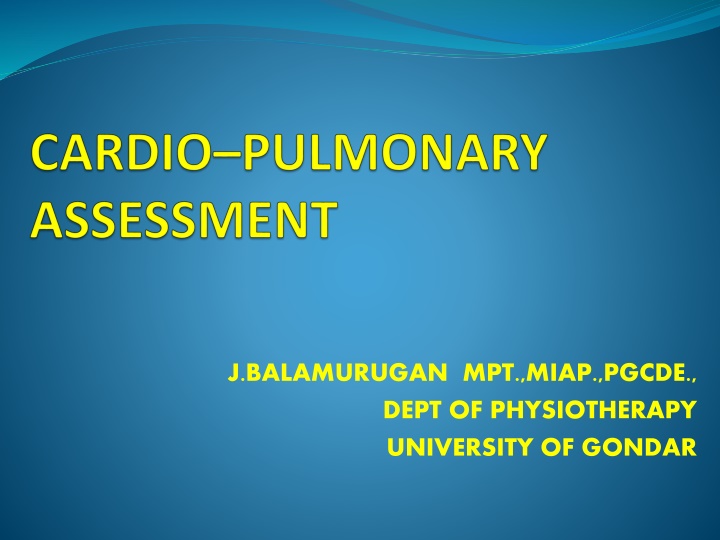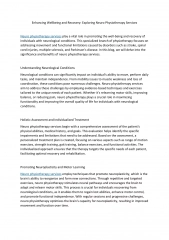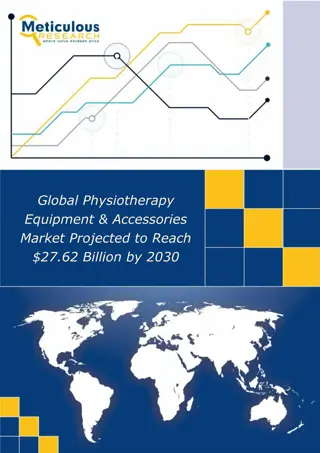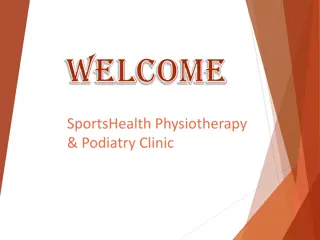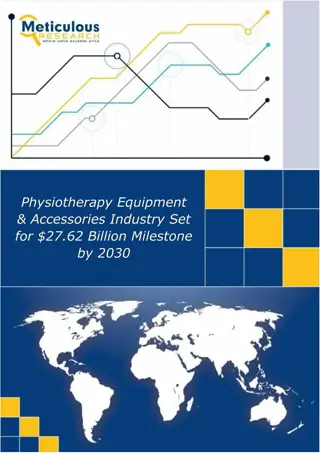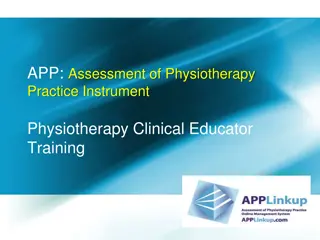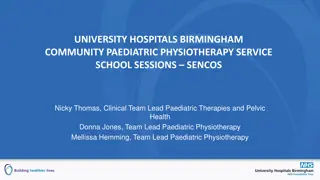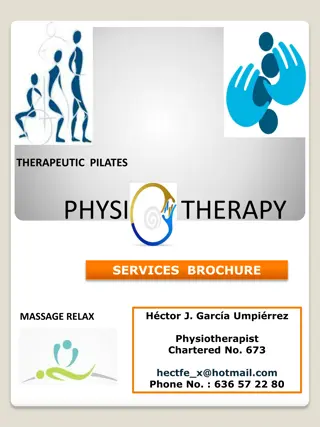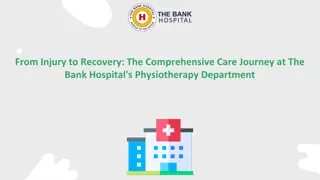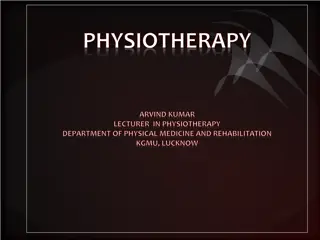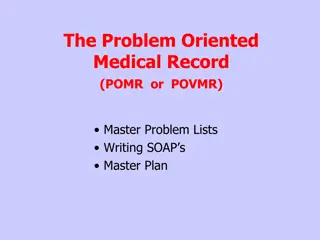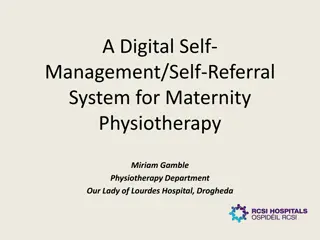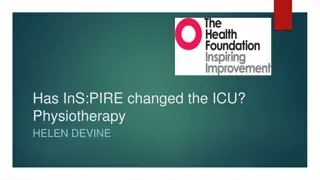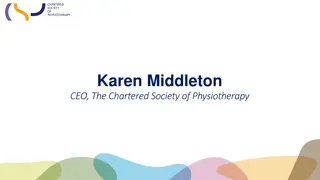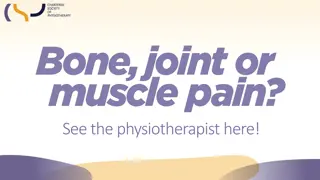Comprehensive Overview of Problem-Oriented Medical System in Physiotherapy Assessment
In the realm of physiotherapy assessment, the Problem-Oriented Medical System (POMS) plays a vital role in accurately defining patient problems, creating treatment plans, and monitoring progress. This system, pioneered by Weed in 1968, consists of Problem-Oriented Medical Records (POMR), auditing, and educational programs. The process involves initial data collection, subjective and objective assessments, problem analysis, goal setting, treatment planning, outcome assessment, and discharge summaries. Additionally, demographic data and chief complaints are crucial elements in understanding the patient's condition and history. By following the structured POMR format, physiotherapists can effectively manage and track patient care.
Download Presentation

Please find below an Image/Link to download the presentation.
The content on the website is provided AS IS for your information and personal use only. It may not be sold, licensed, or shared on other websites without obtaining consent from the author.If you encounter any issues during the download, it is possible that the publisher has removed the file from their server.
You are allowed to download the files provided on this website for personal or commercial use, subject to the condition that they are used lawfully. All files are the property of their respective owners.
The content on the website is provided AS IS for your information and personal use only. It may not be sold, licensed, or shared on other websites without obtaining consent from the author.
E N D
Presentation Transcript
J.BALAMURUGAN MPT.,MIAP.,PGCDE., DEPT OF PHYSIOTHERAPY UNIVERSITY OF GONDAR
AIMS OF ASSESSMENT Todefine thepatient's problemsaccurately. based on both a subjective and an objective assessment of the patient Todevelopan appropriateplanof treatment. Toassess effectiveness of treatmentregularly in relation to both theproblemsand goals.
THE PROBLEM ORIENTED MEDICAL SYSTEM (POMS) WAS FIRST DESCRIBED BY WEED IN 1968 THIS SYSTEM HAS THREE COMPONENTS Problem oriented medical records (POMR) Audit Educational programme THE POMR IS USED AS THE METHOD OF RECORDING THE Assessment Management Progress of a patient.
PROCESS OF POMR FORMAT INITIAL DATA FROM NOTES DATA BASE SUBJECTIVE ASSESSMENT OBJECTIVE ASSESSMENT ANALYSIS PROBLEM LIST PROBLEM LIST GOALS(SHORT AND LONG TERM) INITIAL PLAN TREATMENT PLAN Treatment ASSESS OUTCOME OF TREATMENT PROGRESS NOTE IS CURRENT GOALS ATTAINNED NO YES YES ANY FURTHER GOALS TO ADDRESS NO DISCHARGE SUMMARY DISCHARGE
DEMOGRAPHIC DATA Date/Time of Assessment/Documentation: Name of Assessor: Name of the informant/record: NAME: PATIENT ID NO: AGE: HEIGHT: WEIGHT: BMI: SEX: RACE: OCCUPATION: ADDRESS FOR COMMUNICATION: REFFERED BY: Reason for referral: HANDEDNESS: Brief list of Patients significant problem:
CHIEF COMPLAINTS Reason given by patient for seeking medical care and the duration of the symptom. List all of the patients medical problems VITAL SIGNS/PARAMETERS/CHECK RED FLAGS Pulse rate(artery): Breath rate: Temperature: Blood pressure: SpO2: Pain: Remember that patient satisfaction is greatest if the patient is allowed to fully express major concerns without interrupting. In addition, the risk of missing what is really of greatest concern to the patient is reduced if the patient is allowed sufficient time to describe it in his or her own words. NOTE
HISTORY OF PRESENT ILLNESS (HPI): Describe the course of the patient's illness When it began Character of the symptoms Location where the symptoms began Aggravating or alleviating factors Pertinent positives and negatives. Describe past illnesses or surgeries, and past diagnostic testing related to present illness
Past Medical History (PMH): Past diseases Surgeries and drugs history with dosage Hospitalizations Prior treatments Medical problems History of diabetes Hypertension Peptic ulcer disease Asthma Coronary artery diseases Respiratory diseases Cancer/AIDS/TB In children include immunizations, and type of feedings Medications, Allergies(drugs, food) birth history, prenatal history, written in disease-specific groupings or as a chronological account
FAMILY HISTORY Medical problems in family, including the patient's disorder. Asthma Coronary artery disease Heart failure Cancer Tuberculosis Diabetes mellitus Hyper lipideamia Hereditary disorder FAMILY TREE FAMILY TREE F M F M Mother Father PATIENT Sister Brother
PERSONNEL HISTORY LIFE STYLE: SEDENTARY, ACTIVE ,REGULAR EXERCISE HABITS: SMOKING,ALCOHOL,TOBACCO CHEWING,DRUG ABUSE SLEEP PATTERN FOOD PREFERENCE: VEG/NON-VEG, CHAT PERSONALITY TYPE: EDUCATION LEVEL: ALLERGIC foods, pollen grains, dust, animals, drugs.
SOCIO-ECONOMIC HISTORY DWELLING PLACE: URBAN/RURAL, OWN/RENTED,PICTURE OF THE PATIENT'S SOCIAL SITUATION. LAY OUT DETAILS LIKE PRESENCE OF STAIRS,ETC LEVEL OF SUPPORT AVAILABLE AT HOME MARITAL STATUS: SINGLE/MARRIED/WIDOW/WIDOWER/SEPERATED ECONOMIC STATUS: Poor/Low/Middle/High MEDICAL INSURANCE IF ANY:
OCCUPATIONAL HISTORY NATURE OF JOB/JOB DEMANDS: LOCALITY OF WORK: DETAILS OF EMPLOYERS SUPPORT: (PERTAINING TO MEDICAL/SICK LEAVES,CASH BENEFITS,COMPENSATION,) AVOCATIONAL HISTORY HOBBIES SPORTS ENTERTAINMENTS
Review of Systems (ROS): General: Weight gain or loss, loss of appetite, fever, chills, fatigue, night sweats. Skin: Rashes, skin discolorations. Head: Headaches, dizziness, masses, seizures. Eyes: Visual changes, eye pain. Ears: Tinnitus, vertigo, hearing loss. Nose: Nose bleeds, discharge, sinus diseases. Mouth and Throat: Dental disease, hoarseness, throat pain. Respiratory: Cough, shortness of breath, sputum (color). Cardiovascular: Chest pain, orthopnea, paroxysmal nocturnal dyspnea; dyspnea on exertion, claudication, edema, valvular disease. Gastrointestinal: Dysphagia, abdominal pain, nausea, vomiting, hematemesis, diarrhea, constipation. Genitourinary: Dysuria, frequency, hesitancy, hematuria, discharge. Gynecological: abortions, last menstrual period (frequency, duration), age of menarche, menopause; dysmenorrhea, contraception, vaginal bleeding, breast masses. Endocrine: Polyuria, polydipsia, skin or hair changes, heat intolerance. Musculoskeletal: Joint pain or swelling, arthritis, myalgias. Skin and Lymphatics: Easy bruising, lymphadenopathy. Neuropsychiatric/CNS: Weakness, seizures, memory changes,Depression
SUBJECTIVE ASSESSMENT based on an interview with the patient FIVE MAIN SYMPTOMS: BREATHLESSNESS (DYSPNOEA) ORTHOPNOEA PAROXYSMAL NOCTURNAL DYSPNOEA (PND) COUGH SPUTUM AND HAEMOPTYSIS WHEEZE/VOICE CHANGE/SNORING CHEST PAIN PLEURITIC CHEST PAIN TRACHEITIS MUSCULOSKELETAL (CHEST WALL) PAIN ANGINA PECTORIS PERICARDITIAL RUB FEVER (PYREXIA PERIPHERAL OEDEMA FUNCTIONAL ABILITY DISEASE AWARENESS POSTURAL HYPOTENSION Enquiries should be made concerning: 1. DURATION:(Both absolute time and present symptom) 2. SEVERITY : Absolute and recent past. 3. PATTERN: Seasonal and daily variation. 4. ASSOCIATED FACTORS: Precipitating, Relieving Use open-ended questions
OBJECTIVE ASSESSMENT Based on examination of the patient
NOTE NORMAL RANGES Heart rate: Normal range: 50-100 bpm Brady cardia: < 50 bpm Tachy cardia: >100 bpm Arterial blood pressure(BP) Normal range 95-120/65-90 mm Hg Saturation of O2 SpO2 > 95% Pulmonary artery pressure PAP Normal range : 10-20 mm Hg Breath rate Normal:12-20 per min Central Venous Pressure CVP 3-15 mm Hg Note palpable Jugular pulse Cardiac enzymes CPK< 150 U/L ABG PaO2 : 80-100 mmHg, PaCO2: 35-45 mmHg, pH:7.35-7.45 Capillary refill Normal: < 3 min Low Cardiac Output/low peripheral perfusion: >3 min
Central nervous system Intracranial pressure: Normal value < 10 mmHg Critical value >25 mmHg Cerebral perfusion pressure Normal value >70 mmHg Critical value <50 mmHg Level of consciousness (Glasgow coma scale), orientation (time, person, place). Pupil size/reactivity/equality. Ability to maintain a patent airway. Sensorimotor loss, speech disturbances. Level of pain/agitation.
ON OBSERVATION: BUILT OF THE PATIENT: MESO,ENDO,ECTOMORPIC POSITION OF PATIENT AND FACE (awake, alert, disoriented, anxious, depressed, cyanosed, pink, Purse lipped, nostril flaring) NECK (usage of accessory muscles), SKIN (color, scar, texture, incisions', hair loss) CHEST SHAPE/LAND MARKS/JVP(DISTENSION) SHORTNESS OF BREATH/ACCESSORY MUSCLE WORK IN REST BREATHLESS TO SPEAK LINES CONNECTED (IN BED)-IV, CATHETERS,O2,VENTILATOR SETTINGS(ICU) CYANOSIS-CENTRAL/PERIPHERAL LEVEL OF CONCIOUNOUS CLUBBING/NAIL BED COLOUR PEDAL OEDEMA BREATHING PATTERN (shallow or deep, Adb-thoraco or Thoraco-Adb) HOARNESS OF VOICE/WHEEZE
ON PALPATION BODY TEMPERATURE: Normal (36.5-37.5) For every 0.6 C (1 F) rise in body temperature, there is an approximately 10% increase in oxygen consumption and carbon dioxide production. PULSE RATE: HEART RATE: (Note: Pulse deficit) CAPILLARY FILLING: TRACHEAL DEVIATION: VOCAL /TACTILE FREMITUS: PERCUSSION: CHEST WALL EXPANSION(look for Symmetry) OEDEMA (pitting or Non-pitting) TENDERNESS PERIPHERAL PULSES: AUSCULTATION BREATH SOUNDS- Wheeze, Crackles, Pleural rub, Vocal resonance HEART SOUNDS- S1, S2, S3, S4, Murmurs.
Examination Chest expansion measurement MRC Diaphragm/Mediated percussion ROM thoracic spine
INVESTIGATIONS AND TESTS CHEST RADIOGRAPH(X-RAY) ULTRASONOGRAPH COMPUTARISED TOMOGRAPH MAGNETIC RESONANCE IMAGING ECHO CARDIO GRAPH/DOPPLER ECHO ELECTRO CARDIO GRAPH/STRESS ECG PULMONARY FUNCTION TEST(SPIROMETRY) CENTRAL VENOUS PRESSURE MONITORING ARTERIAL BLOOD GASES ANALYSIS- PAO2,PACO2,PH,BICARBONATE ROUTINE BLOOD TEST/CARDIAC ENZYMES INTRA ARTERIAL CATHETERS EXERCISE STRESS TESTING/EXERCISE CAPACITY TEST-SHUTTLE WALK TEST SPUTUM CULTURE TRANSESOPHAGEAL ECHO CARDIOGRAPHY (TEE) CARDIAC ANGIOGRAPHY BRONCHOSCOPY PULMONARY ANGIOGRAPHY
PROBLEM LIST THE LIST CONSISTS OF A SIMPLE, FUNCTIONAL AND SPECIFIC LIST OF THE PATIENT'S PROBLEMS. EACH PROBLEM IS NUMBERED AND DATED AT THE TIME OF ASSESSMENT. THE BEST SYSTEM IS ONE THAT IS INDIVIDUALIZED TO EACH PATIENT PROBLEMS ONCE RESOLVED SHOULD BE SIGNED OFF AND DATED. ANY SUBSEQUENT PROBLEMS ARE ADDED AND DATED APPROPRIATELY.
INITIAL PLANS Based on the problem list short term and long term goals are formulated It should be SMART i.e MEASURABLE, ACHIEVABLE, REALISTIC and TIMED SPECIFIC, A treatment plan is then devised for each of these goals. This process must be performed, where possible, in consultation with the patient. Long-term goals Short term goals The short-term goals, should be reviewed regularly as some patients may improve faster than others. If goals are not met within the agreed time frame, then necessary. If continued discharge, one of the goals must be to teach the patient or a relative how to perform the treatment effectively physiotherapy is to be at home after revision is
PROGRESS NOTES REPORTS ON DAILY BASIS USING THE SUBJECTIVE, OBJECTIVE, ANALYSIS, PLAN' (SOAP) FORMAT. ANALYSIS - THE PHYSIOTHERAPIST'S PROFESSIONAL OPINION OF THE SUBJECTIVE AND OBJECTIVE FINDINGS PLAN - INCLUDING CHANGES IN TREATMENT AND ANY FURTHER ACTION. ONE OF THE BEST INDICATORS OF OUTCOME IS THE CHANGE IN OBJECTIVE FINDINGS AFTER TREATMENT CHEST AUSCULTATION TREATMENT MAY PROVIDE A SIMPLE INDICATION OF THE EFFECTIVENESS OF THAT TREATMENT ANALYSIS OF OUTCOME IS THEN COMPARED WITH THAT OF EXPECTED (I.E. THE GOALS). BEFORE AND AFTER A PROGRESS NOTE MAY ALSO INCLUDE FLOW CHART AND GRAPH
HOME ADVICE, PATIENT EDUCATION, PATIENT SAFETY Cardiopulmonary patient education poses a significant challenge Benefits are: 1.Enhanced patient-clinician rapport 2. In creased patient knowledge of health disorder/condition 3. Increased adherence to physical therapy treatment plant 4. Decreased health-care costs 5. Increased patient self-efficacy 6. Increased ability to make informed health-care choices
DISCHARGE SUMMARY PREPARED UPON DISCHARGE OR TRANSFER ELSEWHERE Summary should be written of the patient's initial problems, treatment and outcomes. Instruction for home programmes and any other relevant information should also be included. Discharge summaries are helpful to other physiotherapists who may treat the patient in the future. The summary should always contain adequate information for future audit and studies of patient care.
AUDIT *AUDIT* REFERS TO THE SYSTEMATIC AND CRITICAL ANALYSIS OF THE QUALITY OF CARE. THREE TYPES STRUCTURAL AUDIT (ADDRESS THE AVAILABILITY OF HUMAN AND EQUIPMENT) PROCESS AUDIT (INVESTIGATES THE SYSTEM OF DELIVERY OF CARE) OUTCOME AUDIT (CLINICALLY BASED AUDIT IT EXAMINES THE RESULTS OF PHYSIOTHERAPY CARE) AUDIT PROCESS IS CYCLICAL
CONCLUSION Accurate assessment should reveal the exact nature of the patient's problems and delineate those that physiotherapy can improve. Only then can the best treatment be chosen for the patient. Subsequent reassessment is essential to ensure that treatment is specific, effective and efficient. This process ensures high-quality patient care.
